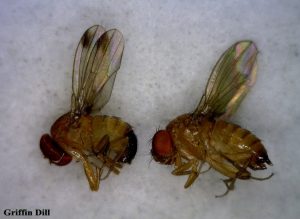What Home Gardeners Need to Know about Spotted Wing Drosophila

Click on photos to enlarge.
Spotted wing drosophila (Drosophila suzukii) is a new insect pest that can infest berries and other soft fruit that ripen from mid-summer through fall, including day-neutral (everbearing) strawberries, raspberries and blueberries. This is a small fruit fly, similar to the type that hovers around the over-ripe bananas in your kitchen. However, unlike other fruit fly species, spotted wing drosophila will lay its eggs in fruit before it ripens, causing the fruit to be contaminated with small white maggots just as it is ready to pick. Infested fruit quickly softens and has no shelf life.
Spotted wing drosophila recently came into the U.S. from northern Asia, and has infested berry crops from California to Maine over the past three years. Each female fly can lay hundreds of eggs, and a new generation can be completed in less than two weeks. Thus, millions of flies can be present soon after the introduction of just a few into a field. This makes spotted wing drosophila very difficult to control, and frequently repeated insecticide sprays (1 to 2 times per week) may be needed to prevent infestations once the insect is present in a field.
Spotted winged drosophila can successfully overwinter in Maine, although it may not build up to damaging levels until late in the summer. Keeping fields clean of over-ripe and rotten fruit can reduce the incidence of this insect. Good pruning to keep plants open can also reduce drosophila populations, because they prefer a shady, humid environment. Covering small plantings with a fine screen mesh can provide a barrier to keep the flies away from developing fruit. The mesh size must be no larger than one millimeter to be effective.
Traps for spotted wing drosophila are easy to make and may catch lots of the flies, but they may not be effective in keeping all flies out of the fruit. A red plastic 16 to 18-ounce cup with a lid and about 20 holes, 1/8” in diameter, drilled up near the rim will make a good trap. Leave one side of the cup with no holes so that liquid can be poured in and out. Bait the trap with about 4 ounces of apple cider vinegar and place it near the planting in a cool, shady area just a foot or so off the ground. Empty and re-bait the trap weekly, but do not pour the old bait on the ground near the trap. Traps are mostly used to monitor for the presence of spotted wing drosophila. Other species will also be attracted to the bait, so you must be able to properly identify the species. Several fact sheets are available online to help with identification. Using traps to control the flies has not proven highly effective or practical. Traps need to be placed no more than 20 feet apart within each plant row in order to catch enough flies to reduce injury to the fruit.
Insecticides that can provide control of drosophila include spinosad, pyrethrum, and malathion. If you choose to use an insecticide, look for a product that contains one of these ingredients and is approved for use on the crop you are trying to protect. Follow all product label instructions and precautions. Applications should begin when spotted wing drosophila is known to be active in the vicinity and the fruit has started to color. Spraying once weekly may provide adequate control, but tightening the spray schedule to every 3 to 5 days may be necessary under heavy infestations.
For information on identifying spotted wing drosophila and making your own monitoring traps, visit Penn State’s Spotted Wing Drosophila website.

